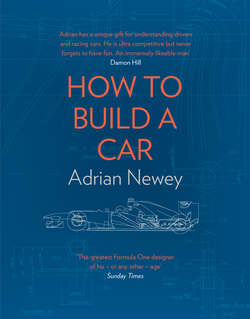Читать книгу How to Build a Car: The Autobiography of the World’s Greatest Formula 1 Designer - Adrian Newey, Adrian Newey - Страница 23
Turn Two
HOW TO BUILD A MARCH 86C
CHAPTER 21
ОглавлениеBy the time we got to the first race of the season at Long Beach, we were about three weeks behind schedule. Even so, Mario dominated the race and won. I remember it with some fondness. Not just because we won, but because Amanda brought Charlotte along, who by then was six or seven months old. We were having dinner with Paul Newman that night, and there was a great picture – since lost, sadly – of Paul bouncing Charlotte on his knee.
It was nice to get to know Paul. In addition to our end-of-term concert at Repton, we had end-of-term films, and though most of them were pretty boring, two stood out: If … starring Malcolm McDowell – memorable for reasons that will be obvious if you’ve seen the film – and Butch Cassidy and the Sundance Kid, which of course starred Paul.
Paul turned out to be a lovely chap, and we often spoke about films and motor racing. I’m strangely immune to celebrities, perhaps in part because motor racing attracts many musicians and actors to race days, often as guests of the teams. In my experience they tend to fall into two distinct categories: those who remain unaffected by their fame, and those who think that being famous entitles them to act like a prima donna. Paul was in the former camp. Down-to-earth, charming and pragmatic to the point that he’d take the stairs rather than a lift, claiming that the exercise helped him cut down on gym fees.
He didn’t like being interrupted by fans when he was eating, which having also experienced I can fully understand, and he used to charge people for an autograph, which tended to take people aback until they discovered he wanted them to donate the money to the Scott Newman Centre in remembrance of his son, Scott, who had died of a drug overdose in 1978.
The next race was Phoenix, where Mario put it on pole. However, as the race went on, the car became progressively more ‘loose’, which is an American way of saying that it was oversteering. We had a radio in the car by now, and Mario was reporting horrendous amounts of oversteer. It wasn’t until later that we discovered the car had a broken engine mount.
Thanks to Mario’s commitment and skill, we somehow came third, despite a back end that was flexing all over the place. For me, that has to be one of the greatest unsung drives ever, because the car must have been truly evil to drive.
Meanwhile, the team was still getting to grips with some of the modifications we’d made to the car. We’d also developed a new system for pit-stops. Nowadays, in Formula One, mechanics use jacks at the front and rear when the car comes in for a pit-stop, but in IndyCar we had pneumatically powered air jacks on board.
Race engineering Mario with my clipboard, ’87.
We also had a relatively small fuel tank, so needed to refuel several times each race. At the pit-stops you could then change tyres, depending on your strategy. There would be a low wall in the pit lane, and behind that was kept the fuel rig, wheels for the next pit-stop and whatever other bits might be needed.
Only five people were allowed on the pit side of the low wall. Two of those were for refuelling, one on the filling pipe and one on the ventilation pipe. The ventilation-pipe guy would also operate the air jacks.
The reason the IndyCars have jacks on board is because of this limitation on how many people are allowed in the pit lane. A front and rear jack man would mean two extra people.
So, at a pit-stop, you’d have all five people waiting for the car to arrive. Your refuelling and jack man would start refuelling and lifting the car. Typically, you’d have two people, one to change each rear wheel, after which you had a choice of what to do with your front wheels. If you wanted to change both of them, the front-wheel guy had to change the outside front wheel, then run across the front of the car and change the inside front wheel. Three wheels could be changed in the time it took to refuel, but to change all four would add an extra 4sec or so to the pit-stop time.
As race engineer I would make the call on whether we would change that extra tyre and also on what we should adjust on the set-up of the car to keep it balanced for the remainder of the race. It was up to the driver to adjust the car’s balance using the anti-roll bars front and rear. Some drivers knew what to do for themselves; others would prefer to radio in, tell you what the car was doing and wait for adjustment advice. The car tends towards oversteer as the race goes on because it loses more rear grip than it does front grip – not always the case, it depends on factors like the ambient temperature, the track temperature, the layout of the circuit, the characteristics of the tyres and so on – but as a rule of thumb, it loses more rear grip as the tyres degrade, so the driver would typically soften the rear bar and stiffen the front bar to maintain balance as the tyres degraded through a stint.
